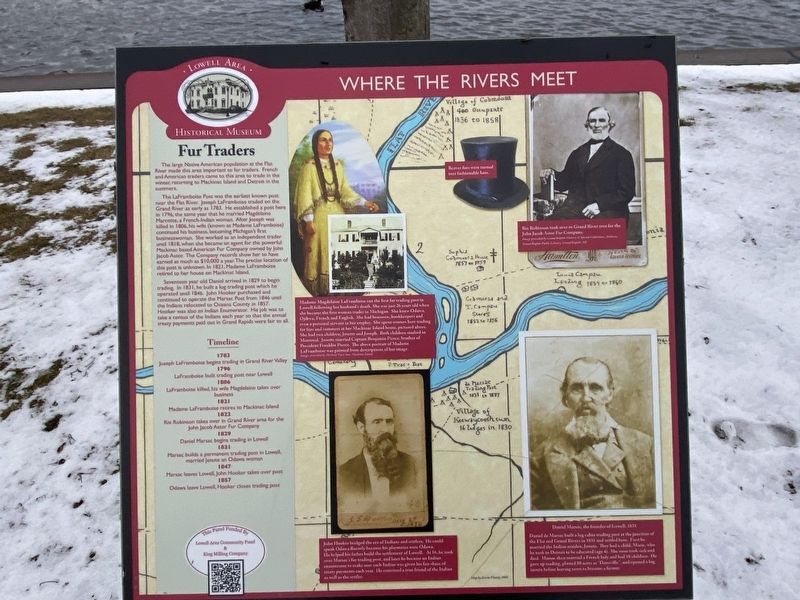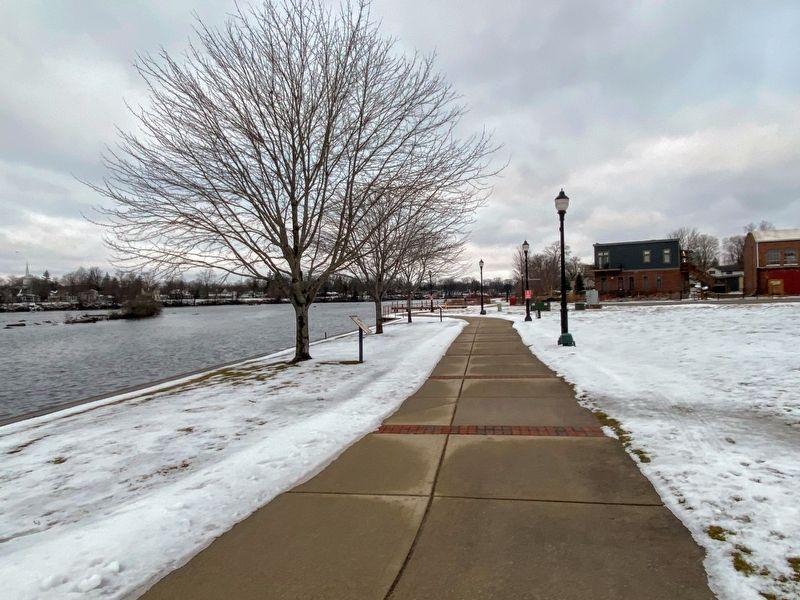Vergennes Township in Lowell in Kent County, Michigan — The American Midwest (Great Lakes)
Fur Traders
Where The Rivers Meet
The LaFramboise Post was the earliest known post near the Flat River. Joseph LaFramboise traded on the Grand River as early as 1783. He established a post here in 1796, the same year that he married Magdelaine Marcotte, a French-Indian woman. After Joseph was killed in 1806, his wife (known as Madame LaFramboise) continued his business, becoming Michigan's first businesswoman. She worked as an independent trader until 1818, when she became an agent for the powerful Mackinac based American Fur Company owned by John Jacob Astor. The Company records show her to have earned as much as $10,000 a year. The precise location of this post is unknown. In 1821, Madame LaFramboise retired to her house on Mackinac Island.
Seventeen year old Daniel arrived in 1829 to begin trading. In 1831, he built a log trading post which he operated until 1846. John Hooker purchased and continued to operate the Marsac Post from 1846 until the Indians relocated to Oceana County in 1857. Hooker was also an Indian Enumerator. His job was to take a census of the Indians each year so that the annual treaty payments paid out in Grand Rapids were fair to all.
Timeline
1783
Joseph LaFramboise begins trading in Grand River Valley
1796
LaFramboise built trading post near Lowell
1806
LaFramboise killed, his wife Magdelaine takes over business
1821
Madame LaFramboise retires to Mackinac Island
1822
Rix Robinson takes over in Grand River area for the John Jacob Astor Fur Company
1829
Daniel Marsac begins trading in Lowell
1831
Marsac builds a permanent trading post in Lowell, married Jenute an Odawa woman
1847
Marsac leaves Lowell, John Hooker takes over post
1857
Odawa leave Lowell, Hooker closes trading post
Madame Magdelaine LaFramboise ran the first fur trading post in Lowell following her husband's death. She was just 26 years old when she became the first woman trader in Michigan. She knew Odawa, Ojibwa, French and English. She had boatmen, bookkeepers and even a personal servant in her employ. She spent winters here trading for furs and summers at her Mackinac Island home, pictured above. She had two children, Josette and Joseph. Both children studied in Montreal. Josette married Captain Benjamin Pierce, brother of President Franklin Pierce. The above portrait of Madame LaFramboise was painted from descriptions of her image.
John Hooker bridged the era of Indians and settlers. He could speak Odawa fluently because his playmates were Odawa. He helped his father build the settlement of Lowell. At 16, he took over Marsac's fur trading post, and later he became an Indian enumerator to make sure each Indian was given his fair share of treaty payments each year. He remained a true friend of the Indian as well as the settler.
Beaver furs were turned into fashionable hats.
Rix Robinson took over in Grand River area for the John Jacob Astor Fur Company.
Daniel Marsac, the founder of Lowell, 1831
Daniel de Marsac built a log cabin trading post at the junction of the Flat and Grand Rivers in 1831 and settled here. First he married the Indian maiden, Jenute. They had a child, Marie, who he took to Detroit to be educated (age 4) She soon took sick and died. Marsac then married a French lady and had 10 children. He gave up trading, platted 80 acres as “Dansville”, and opened a log tavern before leaving town to become a farmer.
Erected by Lowell Area Historical Museum.
Topics. This historical marker is listed in these topic lists: Animals • Industry & Commerce • Settlements & Settlers. A significant historical year for this entry is 1783.
Location. 42° 56.149′ N, 85° 20.304′ W. Marker is in Lowell, Michigan, in Kent County. It is in Vergennes Township. Marker can be reached from North Monroe Street near Avery Street. The marker is on the riverwalk west of the Kent District Library. Touch for map. Marker is at or near this postal address: 200 North Monroe Street, Lowell MI 49331, United States of America. Touch for directions.
Other nearby markers. At least 8 other markers are within walking distance of this marker. Native Americans (a few steps from this marker); Lumbering (within shouting distance of this marker); Early Settlers (about 300 feet away, measured in a direct line); Welcome to Lowell (about 400 feet away); On The Bridge (about 500 feet away); Lowell Veterans Memorial (about 500 feet away); Waterpower (about 600 feet away); Lowell Area Veterans Memorial (about 600 feet away). Touch for a list and map of all markers in Lowell.
Credits. This page was last revised on March 5, 2023. It was originally submitted on March 4, 2023, by J.T. Lambrou of New Boston, Michigan. This page has been viewed 89 times since then and 21 times this year. Photos: 1, 2. submitted on March 4, 2023, by J.T. Lambrou of New Boston, Michigan. • J. Makali Bruton was the editor who published this page.

